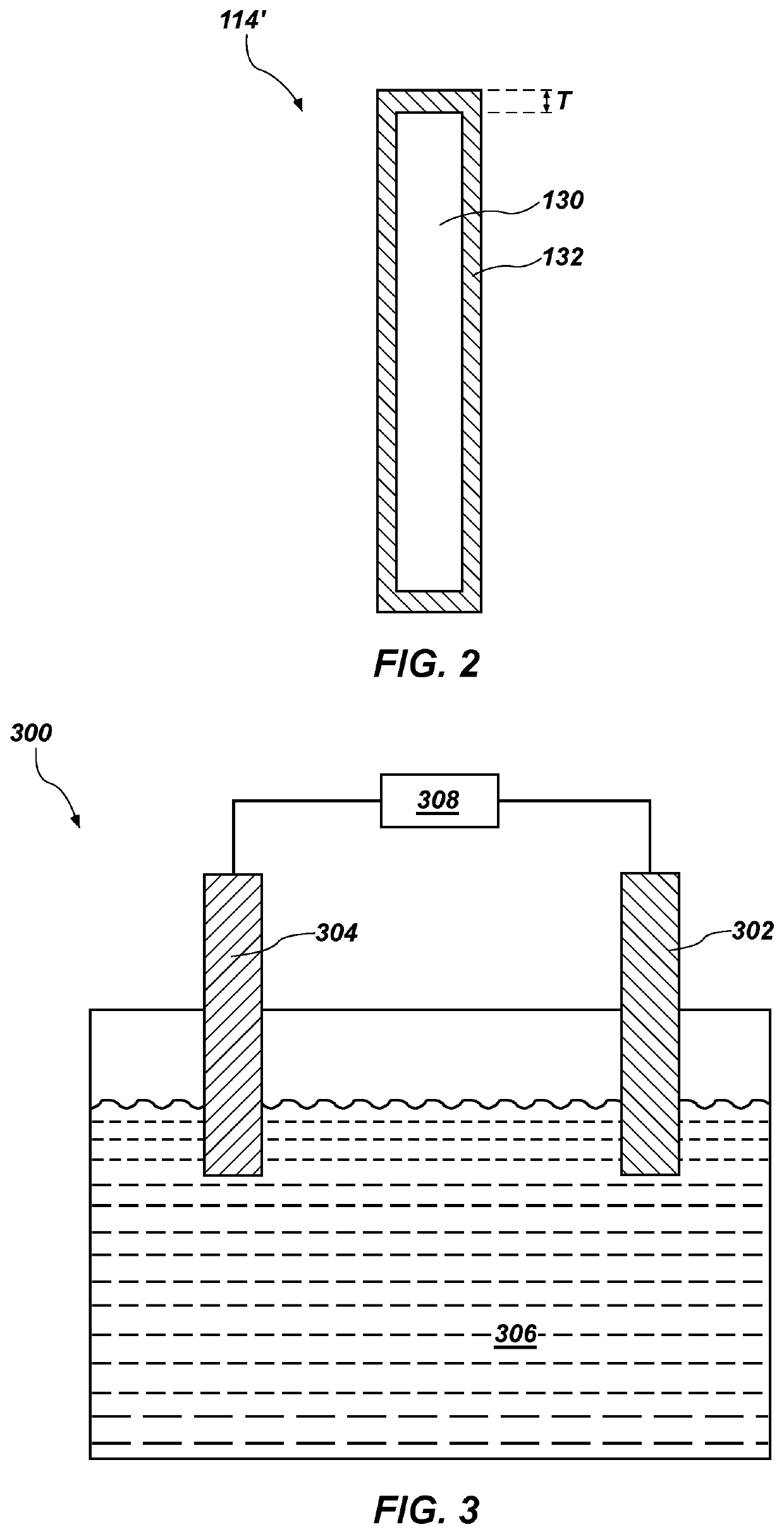Electrochemical cells for direct oxide reduction, and related methods
a technology of electrolyte reduction and electrolyte, applied in the field of electrochemical cells, can solve the problems of molten salt being corroded to one or more portions, unable to use, and eventually dissolving completely in the molten salt electrolyte,
- Summary
- Abstract
- Description
- Claims
- Application Information
AI Technical Summary
Problems solved by technology
Method used
Image
Examples
example 1
[0068]An electrolyte comprising 200 g of high purity anhydrous calcium chloride was prepared. Calcium oxide was added to the electrolyte such that the calcium oxide constituted about 1.0 weight percent of the electrolyte. The electrolyte was melted in an alumina / nickel crucible inside a glove box under an argon atmosphere having less than 0.1 ppm moisture and oxygen. A first monolithic counter electrode (anode) comprising a monolithic rod of iridium and a second counter electrode comprising a monolithic rod of ruthenium, a working electrode (cathode) comprising tantalum pentoxide pellets in a basket, and a reference electrode comprising glassy carbon were cleaned in an ultrasonic bath, oven dried, and disposed in the electrochemical cell. The working electrode included about 18.1 weight percent oxygen. The first counter electrode, the second counter electrode, and reference electrode rods had a diameter of about 3.0 mm and a length of about 100 mm. The working electrode was prepared...
example 2
[0073]A first counter electrode (anode) comprising platinum was disposed in an electrochemical cell including a molten salt electrolyte comprising lithium chloride and lithium oxide. The electrochemical cell included depleted uranium oxide disposed in a working electrode (cathode) basket which was in contact with the cathode lead. A second iridium counter electrode was disposed in the same electrochemical cell. The electrochemical cell was in an argon atmosphere in a glove box.
[0074]A current was applied between and the single cathode and each of the platinum counter electrode and the iridium counter electrode and the metal oxide was reduced in the electrochemical cell. After the metal oxide was substantially reduced, both the platinum counter electrode and the iridium counter electrode were removed and analyzed for mechanical degradation and thinning. The platinum counter electrode exhibited a reduction in diameter of about 17 percent. The iridium counter electrode exhibited a redu...
example 3
[0075]A first counter electrode (anode) comprising monolithic iridium and a second counter electrode (anode) comprising monolithic ruthenium were disposed in an electrochemical cell including a molten salt electrolyte comprising lithium chloride and lithium oxide. The first counter electrode and the second counter electrode comprised rods with a diameter of 3.0 mm and a length of about 100 mm.
[0076]The molten salt electrolyte comprised about 1.0 weight percent lithium oxide. The temperature of the molten salt electrolyte was about 650° C. The electrochemical cell included about 100 grams of unirradiated depleted uranium oxide (UO2) disposed in a stainless steel basket which was in contact with the cathode lead. The electrochemical cell was in an argon atmosphere in a glove box.
[0077]A current was applied between the single cathode and each of the first counter electrode (monolithic iridium) and the second counter electrode (monolithic ruthenium) and the uranium oxide was reduced in ...
PUM
| Property | Measurement | Unit |
|---|---|---|
| temperatures | aaaaa | aaaaa |
| temperatures | aaaaa | aaaaa |
| weight percent | aaaaa | aaaaa |
Abstract
Description
Claims
Application Information
 Login to View More
Login to View More - R&D Engineer
- R&D Manager
- IP Professional
- Industry Leading Data Capabilities
- Powerful AI technology
- Patent DNA Extraction
Browse by: Latest US Patents, China's latest patents, Technical Efficacy Thesaurus, Application Domain, Technology Topic, Popular Technical Reports.
© 2024 PatSnap. All rights reserved.Legal|Privacy policy|Modern Slavery Act Transparency Statement|Sitemap|About US| Contact US: help@patsnap.com










